Can Turmeric Be Substituted for Saffron
Occasionally we get asked whether or not turmeric is a good substitute for saffron, and in most cases, we answer with either a flat-out or synonymous phrase for “NO”. This may be surprising to some folks because quite often, turmeric will be suggested as an inexpensive replacement for the world’s most expensive spice. There are really very few instances in which we would ever suggest this; in fact, we would really recommend swapping one out for the other would be when you are simply looking for a food-safe agent for turning a dish yellow because they impart very different flavors into the dish. If you are looking for an organic option for dying fabric, you might also try turmeric as a way of cutting costs.
Why, specifically, do we not recommend replacing saffron with turmeric in recipes? Let’s take a look.
Why Saffron and Turmeric Should Not Be Used Interchangeably
Saffron has a very distinctive taste
Spice novices might look to turmeric and saffron as similar ingredients solely based on color, while spice aficionados look to the flavor intricacies of every individual spice as something to be marveled at and appreciate uniqueness of each. Sure, there are some ingredients that have similar flavor profiles and can be swapped out in a pinch, but that is not really the case with saffron. Until one has experienced the tastes of saffron, they will not be able to fully comprehend this fact.
Considering saffron threads are actually parts of a flower: stigmas and styles of crocus, it’s not hard to believe that this spice contributes a natural sweetness to dishes it is added to—not as concentrated of sweetness as honey, but of a similar profile. Though the sweetness doesn’t stand on its own, it is elevated by a savory and earthy tone of what one might expect fresh-cut, grass to taste like.
Turmeric also contributes an earthy flavor to dishes, but lacks the freshness in its own earth tones—it is more similar to what one might expect dirt or wood to taste like—and aptly so, as it is is a root not a piece of a flower. As one might also expect from the underground portion of edible plants, turmeric has flavor elements that might be described as slightly metallic. Though there are some mild sweet tones that may be revealed in small quantities, it’s a slight bitterness that more often prevails in flavor descriptions of this spice.
Aromas of Saffron and Turmeric are Quite Different
Take one whiff of saffron and you’ll quickly recognize the fact that saffron is an idiosyncratic ingredient—one with a distinctive profile that is dissimilar to any other spice you’ve come across. As with the taste, the aroma of saffron is often described as floral and earthy, but it is truly unique, unlike any flower you have had the pleasure of smelling or earth-like quality you can conjure in your mind. It’s like walking through a field of roses, lined with jasmine while a salty, sea-side breeze blows wafts of air through oak groves and fields of fresh-cut grass prior to reaching you. Yeah, it’s that good.
Turmeric, on the other hand, is a root, and as such, bestows its own distinctive earth-like aromatic qualities at the forefront. It is no less unique, with an intense mustiness and notes of pepper and mustard seed, much like its close relative, ginger root. It too puts off a slightly sweet odor but is much milder than saffron and almost citrus-like as compared to being considered floral.
Conclusion
We definitely don’t have a problem with turmeric, and it’s a spice that definitely deserves its time and place to shine. That said, it’s a far cry from saffron and a very different ingredient altogether, beloved and unique in its own way. As such, we believe the two should not be used interchangeably if you are hoping to achieve a specific flavor or aroma in your dish.
If your recipe calls for saffron but you want to save money, we don't suggest replacing it with a different ingredient, instead purchase a high-quality saffron that is going to infuse a wealth of flavor into your dish. You see, just a pinch of saffron goes a long way when it comes to introducing flavor, aroma, and color into your dish.
Check out our full line of high-quality saffron here, with prices starting as low as $7.99.







Slofoodgroup
Author